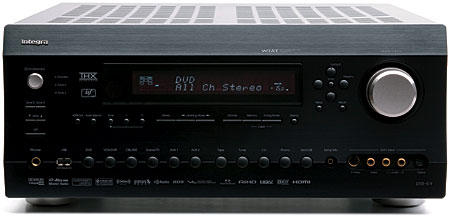Integra DTR-9.9 A/V Receiver
 Price: $2,600 At A Glance: Outstanding audio and video performance • All the latest Audyssey and THX Ultra2 Plus features • Uniquely flexible video calibration controls
Price: $2,600 At A Glance: Outstanding audio and video performance • All the latest Audyssey and THX Ultra2 Plus features • Uniquely flexible video calibration controls
Covering All the Bases
If you sometimes get nostalgic for the days of two-channel audio, you’re not alone. Life was simple then. You plugged in your CD player here, your turntable over there, hooked up the preamp to the power amp (unless you were a hair-shirt audiophile with an all-in-one, integrated amp), and you were done. Then you would select the source, adjust the volume, sit back, and listen.

Home theater is a whole new game, as anyone who has owned one of today’s multifunctional A/V receivers knows. If a new feature is developed, it’s in there.
Now that so many features are implemented in software, it adds little to the basic build cost to pile on the flexibility in a limited number of models.
The Vital Stats
The owner’s manual for the THX Ultra2 Plus–certified Integra DTR-9.9 covers 160 densely packed, single-language pages. Fortunately, like most new receivers today, you can easily ignore the capabilities you don’t need, at least at first, and concentrate on what you do. The onscreen menus are easy to follow. You can do a manual setup in less than half an hour with minimum (or no) reference to the instructions.
The Integra will handle all of the new high-resolution audio formats, including Dolby TrueHD and DTS-HD Master Audio in either bitstream form or (if decoded by a Blu-ray player) multichannel PCM.
You can play back two-channel material in Stereo mode (full digital processing, including the subwoofer crossovers), or Direct mode (which drives the left and right speakers full range, with no sub). Apart from digital-to-analog conversion, if needed, the Direct mode bypasses all digital processing and keeps the analog inputs in analog form all the way to the speaker outputs. The 7.1-channel analog input is always a direct bypass with no processing.

Integra’s AVR also includes the usual bewildering assortment of modes to play back two-channel stereo in 5.1 or 7.1 in simulated surround. For all of the listening comments in this report, I avoided this pseudo-surround hocus-pocus. I auditioned two-channel sources in two channels with subwoofer, surround sources in their native habitat, and bitstream inputs to the receiver in order to test this AVR’s full decoding capabilities.
The Integra will also play back multichannel DSD, which is the digital format that SACD uses. It converts an incoming DSD data stream to PCM for processing. But it must receive the DSD in HDMI bitstream form, and most universal players cannot provide a DSD bitstream. Players that do provide this include Integra’s DPS-6.9, the Pioneer Elite DV-58AV and the OPPO DV-980H. Alternately, of course, you can play back multichannel sources, including SACD and DVD-Audio, through the receiver’s multichannel analog audio inputs.
You can use the Integra’s amp channels in several different ways. You can use them in a 7.1-channel system or a 5.1-channel setup with the extra two channels used to biamp the left and right front speakers—or in a 5.1-channel system with the extra two channels bridged to produce more power to the left and right fronts.
But be careful of that last option. Bridging an amp generally doubles the load impedance that it can safely drive. The signs of distress if you ignore this limitation are overheating and/or shutdown. In extreme cases, this could even damage the receiver.
For my listening, I used a fourth option. I simply set up a conventional 5.1-channel system and left the extra two amplifier channels unused.
On the video side, the Integra provides full video switching, along with deinterlacing and/or scaling by way of an HQV Reon-VX video processor.
The Integra’s video section includes what, as far as we know, is a first in a receiver: calibration controls. It offers high and low controls for red, green, and blue, plus conventional video controls, aspect-ratio settings, and a Gamma control. There are two separate sets of these controls. The set located under Monitor Out (in the Input/Output Assign menu) adjusts all the inputs together. The set under Picture Adjust (in the Source Setup menu) is more detailed and can tweak each input separately. This is useful if you have a single connection from the receiver to the display.
There are three adjustable ISF modes for each input in the Picture Adjust menu: Custom, Day, and Night. The Custom mode is always accessible to the user. The Day and Night modes are locked out and designed to be set up by a calibration specialist with the proper test equipment.
Any adjustments made to these two sets of controls will combine, something that you and your calibrator need to be aware of. Conversely, the resolution setting in the Monitor Out menu will override the resolution setting in the Source Setup menu unless the Resolution in the Monitor Out menu is set to “Source.”
- Log in or register to post comments































































